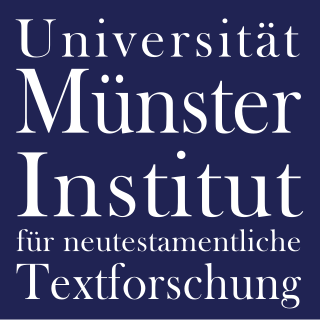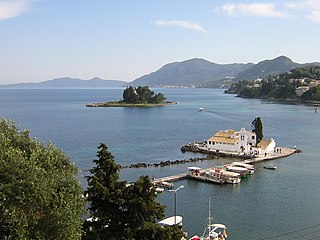Description
The codex contains lessons from the Gospel of John, Matthew, and Luke (Evangelistarium). [4] It contains text of the Pericope Adulterae. [4]

The Gospel of John is the fourth of the canonical gospels. The work is anonymous, although it identifies an unnamed "disciple whom Jesus loved" as the source of its traditions. It is closely related in style and content to the three Johannine epistles, and most scholars treat the four books, along with the Book of Revelation, as a single corpus of Johannine literature, albeit not from the same author.

The Gospel According to Matthew is the first book of the New Testament and one of the three synoptic gospels. It tells how the promised Messiah, Jesus, rejected by Israel, finally sends the disciples to preach the gospel to the whole world. Most scholars believe it was composed between AD 80 and 90, with a range of possibility between AD 70 to 110. The anonymous author was probably a male Jew, standing on the margin between traditional and non-traditional Jewish values, and familiar with technical legal aspects of scripture being debated in his time. Writing in a polished Semitic "synagogue Greek", he drew on three main sources: the Gospel of Mark, the hypothetical collection of sayings known as the Q source, and material unique to his own community, called the M source or "Special Matthew".

The Gospel According to Luke, also called the Gospel of Luke, or simply Luke, is the third of the four canonical Gospels. It tells of the origins, birth, ministry, death, resurrection, and ascension of Jesus Christ.
The text is written in Greek minuscule letters, on 276 paper leaves (26.5 cm by 19.5 cm), in one column per page, 23 lines per page. [1] It contains music notes. [4]
The manuscript contains weekday Gospel lessons. [1]
History
Scrivener and Gregory dated the manuscript to the 16th century. [3] [4] It is presently assigned by the INTF to the 16th century. [1] [2]

The Institute for New Testament Textual Research at the University of Münster, Westphalia, Germany, is to research the textual history of the New Testament and to reconstruct its Greek initial text on the basis of the entire manuscript tradition, the early translations and patristic citations; furthermore the preparation of an Editio Critica Maior based on the entire tradition of the New Testament in Greek manuscripts, early versions and New Testament quotations in ancient Christian literature. Under Kurt Aland's supervision, the INTF collected almost the entire material that was needed - Manuscript count 1950: 4250; 1983: 5460; 2017: approx. 5800.
Formerly it belonged to Papas Zankarol from Corfu. [4]

Corfu or Kerkyra is a Greek island in the Ionian Sea. It is the second largest of the Ionian Islands, and, including its small satellite islands, forms the northwesternmost part of Greece. The island is part of the Corfu regional unit, and is administered as a single municipality, which also includes the smaller islands of Ereikoussa, Mathraki and Othonoi. The municipality has an area of 610,9 km2, the island proper 592,8 km2. The principal city of the island and seat of the municipality is also named Corfu. Corfu is home to the Ionian University.
The manuscript was added to the list of New Testament manuscripts by Scrivener (number 178e) and Gregory (number 272e). Gregory saw the manuscript in 1886. [4]
The manuscript is not cited in the critical editions of the Greek New Testament (UBS3). [5]
Currently the codex is housed at the Biblioteca Marciana (Gr. I.52 (1200)) in Venice. [1] [2]
Lectionary 192, designated by siglum ℓ 192 is a Greek manuscript of the New Testament, on parchment leaves. Palaeographically it has been assigned to the 13th century.
Scrivener labelled it by 264evl.
Lectionary 199, designated by siglum ℓ 199 is a Greek manuscript of the New Testament, on parchment. Palaeographically it has been assigned to the 13th century.
Scrivener labelled it by 207evl.
Lectionary 200, designated by siglum ℓ 200 is a Greek parchment manuscript of the New Testament. Palaeographically it has been assigned to the 12th century.
Scrivener labelled it by 208evl.
Lectionary 202, designated by siglum ℓ 202 is a Greek manuscript of the New Testament, on parchment. Palaeographically it has been assigned to the 12th century.
Scrivener labelled it by 210evl.
The manuscript has complex contents.
Lectionary 207, designated by siglum ℓ 207 is a Greek manuscript of the New Testament, on parchment. Palaeographically it has been assigned to the 12th century.
Scrivener labelled it by 214evl.
The manuscript has complex context.
Lectionary 229, designated by siglum ℓ 229 is a Greek manuscript of the New Testament, on parchment. Palaeographically it has been assigned to the 13th century.
Scrivener labelled it by 223evl.
The manuscript has complex context.
Lectionary 233, designated by siglum ℓ 233 is a Greek manuscript of the New Testament, on parchment. Palaeographically it has been assigned to the 11th century. Scrivener labelled it by 235evl.
Some leaves of the codex were lost.
Lectionary 268, designated by siglum ℓ 268 is a Greek manuscript of the New Testament, on parchment. Palaeographically it has been assigned to the 12th century.
Scrivener labelled it as 174e,
Gregory by 268e. The manuscript has complex contents. Formerly it was known as Nanianus 169.
Lectionary 267, designated by siglum ℓ 267 is a Greek manuscript of the New Testament, on parchment. It is dated by a colophon to the year 1046.
Scrivener labelled it as 173e,
Gregory by 267e. The manuscript is lacunose.
Lectionary 270, designated by siglum ℓ 270 is a Greek manuscript of the New Testament, on paper. Palaeographically it has been assigned to the 14th century.
Scrivener labelled it as 176e,
Gregory by 270e. Formerly it was known as Nanianus 184.The manuscript has complex contents.
Lectionary 271, designated by siglum ℓ 271 is a Greek manuscript of the New Testament, on paper. Palaeographically it has been assigned to the 17th century.
Scrivener labelled it as 177e,
Gregory by 271e. Formerly it was known as Nanianus 222.The manuscript has survived in a fragmentary condition.
Lectionary 273, designated by siglum ℓ 273 is a Greek manuscript of the New Testament, on parchment. Palaeographically it has been assigned to the 13th century.
Lectionary 275, designated by siglum ℓ 275 is a Greek manuscript of the New Testament, on parchment. Palaeographically it has been assigned to the 12th century.
Scrivener labelled it as 181e,
Lectionary 277, designated by siglum ℓ 277 is a Greek manuscript of the New Testament, on paper. Palaeographically it has been assigned to the 15th century.
Frederick Henry Ambrose Scrivener labelled it as 183e,
Lectionary 284, designated by siglum ℓ 284 is a Greek manuscript of the New Testament, on parchment. Palaeographically it has been assigned to the 10th century.
Scrivener labelled it as 163e.
Lectionary 287, designated by siglum ℓ 287 is a Greek manuscript of the New Testament, on parchment. Palaeographically it has been assigned to the 13th century.
Frederick Henry Ambrose Scrivener labelled it as 166e.
Lectionary 290, designated by siglum ℓ 290 is a Greek manuscript of the New Testament, on paper. Palaeographically it has been assigned to the 14th century.
Scrivener labelled it as 169e.
Codex Tischendorfianus V or Lectionary 293 (Gregory-Aland), designated by siglum ℓ 293 is a Greek manuscript of the New Testament, on parchment. Palaeographically it has been assigned to the 8th century.
Scrivener labelled it as 190e.
Lectionary 304 (Gregory-Aland), designated by siglum ℓ 304 is a Greek manuscript of the New Testament, on paper. Palaeographically it has been assigned to the 14th century. The manuscript is lacunose.
Lectionary 305 (Gregory-Aland), designated by siglum ℓ 305 is a Greek manuscript of the New Testament, on parchment. Palaeographically it has been assigned to the 12th century. The manuscript is lacunose.




